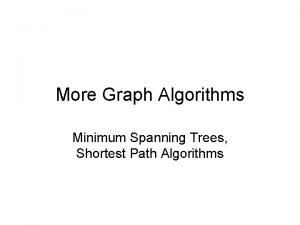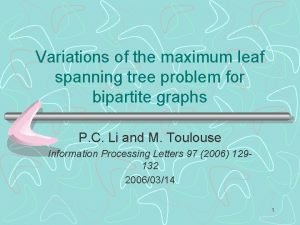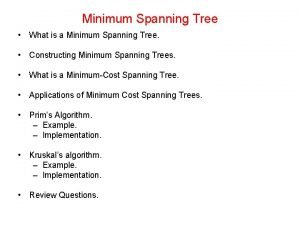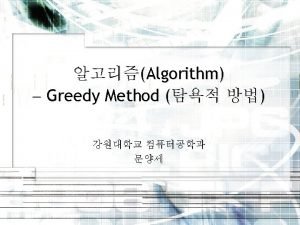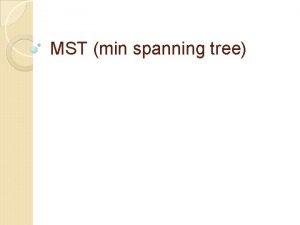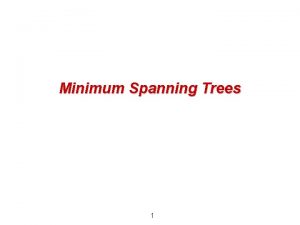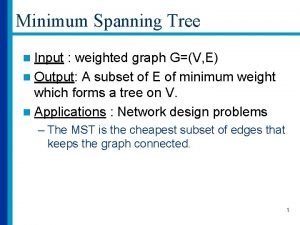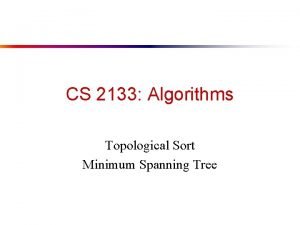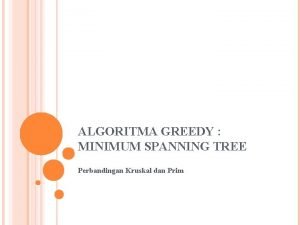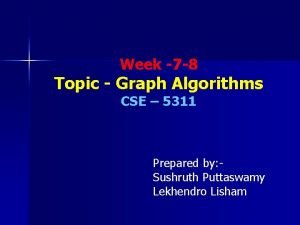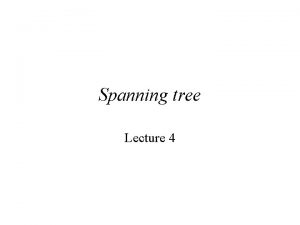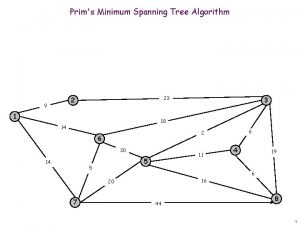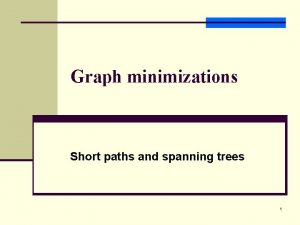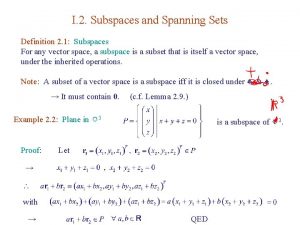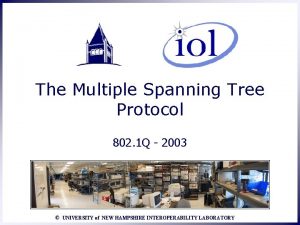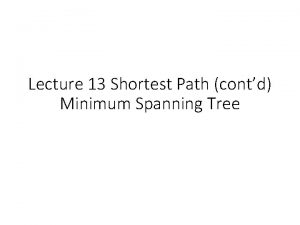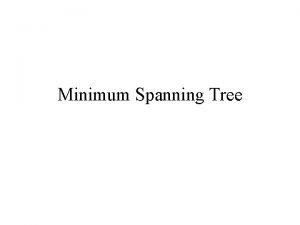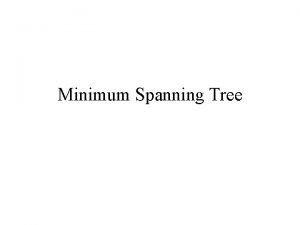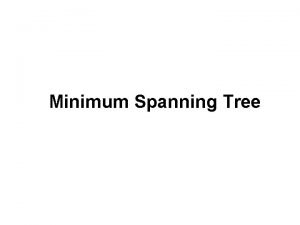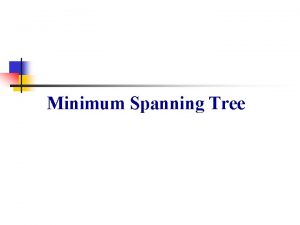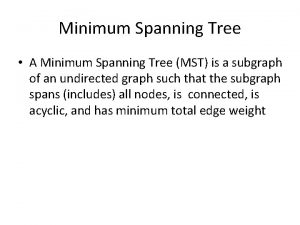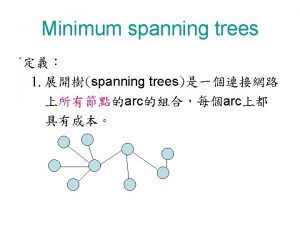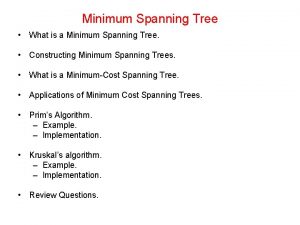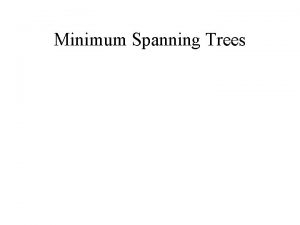Lecture 13 Shortest Path contd Minimum Spanning Tree




![Naïve implementation • Initialize d[s, 0] = 0, d[u, 0] = infinity for other Naïve implementation • Initialize d[s, 0] = 0, d[u, 0] = infinity for other](https://slidetodoc.com/presentation_image_h2/041fe9c7f40af52a8a2e14bdc0f19f92/image-5.jpg)











- Slides: 16

Lecture 13 Shortest Path (cont’d) Minimum Spanning Tree

Shortest Path with negative edge length • What is w(u, v) can be negative? • Motivation: Arbitrage Image from wikipedia

Modeling arbitrage • Suppose u, v are different currency, exchange rate is C(u, v) (1 unit of v is worth C(u, v) units of u) • Let length of edge w(u, v) = log C(u, v) • Length of a path = log of the total exchange rate • Shortest path = best way to exchange money. • Negative cycle = arbitrage.

Approach: dynamic programming with steps • Length of last step Shortest Path to a Predecessor
![Naïve implementation Initialize ds 0 0 du 0 infinity for other Naïve implementation • Initialize d[s, 0] = 0, d[u, 0] = infinity for other](https://slidetodoc.com/presentation_image_h2/041fe9c7f40af52a8a2e14bdc0f19f92/image-5.jpg)
Naïve implementation • Initialize d[s, 0] = 0, d[u, 0] = infinity for other u FOR i = 1 to n Initialize d[u, i] = d[u, i-1] for all i FOR all edges (u, v) IF w[u, v]+d[u, i-1] <= d[v, i] THEN d[v, i] = w[u, v]+d[u, i-1] IF there is a vertex such that d[u, n] <> d[u, n-1] THEN There is a negative cycle!

How to detect a negative cycle? • When the graph has no negative cycle, a shortest path can only contain n-1 edges. (why? ) • If the graph has a negative cycle, then there is a vertex whose shortest path with n edges is shorter than all paths with at most n-1 edges.

Practical Implementation • Running time: • Each iteration takes O(m) time (O(1) per edge) • There are n iterations. • Total running time O(mn) • In practice can be implemented to run efficiently for many graphs • Only consider outgoing edges from u if d[u, i] < d[u, i-1] • Use a queue to keep track of which vertices are “updated”

Minimum Spanning Tree

Minimum Spanning Tree • Input: Undirected graph with edge weights • Edge Weight: w[u, v] = cost of connecting two vertices u, v • w[u, v] > 0 • Goal: Select a subset of edges such that every pair of vertices can be connected by these edges. Minimize the total weight of the edges selected. • Observation: Only need to select n-1 edges and form a tree.

Key Property? • Recall: Any sub-path of a shortest path is still a shortest path. • Dynamic programming based algorithms. • What properties does minimum spanning tree have?

Trees and cycles • Adding any non-tree edge to a tree will introduce a cycle • For a tree with a cycle, removing any edge in the cycle results in a tree. • Basic operation: add an edge and remove another edge in the cycle created (swap).

Why swap? • We will use this to give greedy algorithms for MST. • Recall: Greedy algorithm, general recipe for proof • Assume optimal solution is different from the current solution • Try to find the first place the two solutions differ • Try to modify OPT so that it looks similar to ALG (use swap here!)

Cuts in Graphs •

Question for the greedy algorithm • Given a cut, which edge should we use? • Idea: Use the shortest one (with minimum cost). • (Note: Eventually we may use multiple edges in the cut, this only decides which is the first edge we use)

Key Property •

General Algorithm for MST • Initialize the tree to be empty. (initially a subset of some MST) • Repeat • Find a cut that does not have any edge in the current tree • Add the min cost edge of the cut to the tree (by Key Lemma: still a subset of some MST) • Until the tree has n-1 edges (Now we already have a tree, so it must be a MST)
 Minimum spanning tree shortest path
Minimum spanning tree shortest path Minimum leaf spanning tree
Minimum leaf spanning tree Minimum cost spanning tree
Minimum cost spanning tree Lazy prim's algorithm
Lazy prim's algorithm Dijkstra's algorithm proof
Dijkstra's algorithm proof Minimum spanning tree definition
Minimum spanning tree definition Minimum spanning tree
Minimum spanning tree Minimum spanning tree weighted graph
Minimum spanning tree weighted graph Minimum spanning tree
Minimum spanning tree Solin algorithm
Solin algorithm Minimum spanning tree
Minimum spanning tree Minimum spanning tree
Minimum spanning tree Minimum spanning tree
Minimum spanning tree Minimum spanning tree
Minimum spanning tree Alliance future internetlapowskyprotocol
Alliance future internetlapowskyprotocol Subspaces and spanning sets
Subspaces and spanning sets Common spanning tree
Common spanning tree
